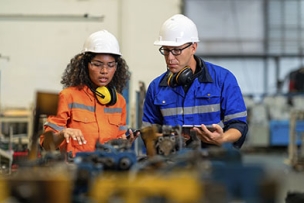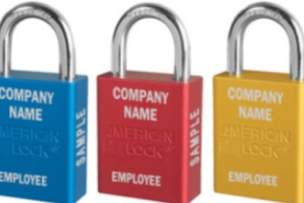A Guide to Industrial Noise, Hearing Loss, NRR and Ear Protection
Do you know the noise level in the workplace and if it is damaging workers’ ears? From sound-level meters, NRR and noise-dampening materials, get a better understanding of the tools and PPE needed to avoid permanent ear damage.
Ear damage caused by exposure to high noise levels at work can be insidious–it may start out gradually, and if not caught early, can result in permanent hearing loss that is not fully evident until a worker retires.
“Hearing loss from noise is very slow, but very cumulative,” says Dr. Cheryl Nadeau, AuD, senior occupational audiologist at Workplace Integra. “The hair cells [sensory cells] within your cochlea do not ever forget that they have been assaulted by noise.”
The Occupational Safety and Health Administration (OSHA) officially recognized the need to protect workers from noise exposure when it published its Hearing Conservation Standard (29 CFR 1910.95) back in 1983. Since that time, scientific studies and advances in testing and hearing protection technologies have prompted further standards and guidance from OSHA and other agencies, such as the American Conference of Governmental Industrial Hygienists (ACGIH).
What Are the Health Effects of Noise in Manufacturing?
In addition to causing permanent hearing loss, loud noise is known to negatively affect the entire body, actually increasing blood pressure, changing blood chemistry and decreasing productivity, Nadeau says.
“Noise puts the body into a fight or flight mode, which can wreak havoc on your hormones,” she says. “Studies have shown that people in a high-noise production area exhibit more anti-social behavior and are less likely to help one another because of the seemingly never-ending noise.”
“Hearing loss from noise is very slow, but very cumulative. The hair cells [sensory cells] within your cochlea do not ever forget that they have been assaulted by noise.”
OSHA’s Regulation on Industrial Noise
On the shop floor, with many pieces of equipment operating at once, noise often assaults workers from several different sources–from machine tools to fork lifts to automated assembly lines. At the same time, workers must be able to communicate with others by voice or radio and be alert to the sound of any warning signals or dangers posed by moving or falling objects.
Good engineering design, noise-damping materials and sound barriers can go a long way to lower noise exposure before it reaches a worker’s ears, says Brandon Hody, a safety and occupational health professional at Concurrent Technologies Corp.
However, if the average noise level a worker is exposed to exceeds 90 decibels (dB) over an 8-hour work shift, OSHA requires personal hearing protection. OSHA also requires workers exposed to average noise levels of 85 dB and higher to be enrolled in a Hearing Conservation Program, where they are monitored with annual audiograms to make sure they are not experiencing a shift in their hearing that may indicate hearing loss.
“To make checking on hearing protection easier, some companies make it a policy to require everyone on the workshop floor to wear it at 85 dB and above,” Nadeau says.
Using a Noise Dosimeter and Understanding Noise Reduction Rating
Different instruments can be used to measure the level of noise a worker is exposed to during the day. Sound-level meters can give a general area reading or a direct reading of the noise level at any given time, such as when a worker is grinding a part, Hody says.
A personal noise dosimeter can record all the noise an individual encounters during the workday and gives a time-weighted average of that person’s total exposure.
“Once you determine that a worker has high levels of noise exposure and needs hearing protection, you want to use protective equipment that has the right level of noise reduction, which is classified according to a noise reduction rating, or NRR,” says Hody.
There are many types of earplugs available at different NRR levels, made from different materials and in different designs to satisfy a range of personal preferences. Selecting the right hearing protection involves a calculation of how much a certain type of ear plug or ear muff will reduce–or attenuate–the noise that a worker is exposed to (see sidebar).
Once the correct NRR has been calculated for a worker, hearing professionals recommend performing a “fit test” to determine the best protective equipment for the individual, and to instruct him or her in the correct way to insert the chosen earplug design.
Finding the Right PPE for Ear Protection: Fit Tests
Fit tests can be performed with a field attenuation estimation system. One popular type consists of a special wired headset that fits over the earplugs in the worker’s ears.
“The person listens through a special headset to tones of different frequencies, and clicks a mouse to indicate when they can’t hear them anymore,” says Jon Di Iorio, vice president of Tasco Corp. “The software calculates the ‘personal attenuation rating’ for the worker to determine if they have done a good job fitting the earplug into their ears.”
If a person get less than half the NRR rating using an earplug, it may mean they’re not fitting the plugs properly in their ears, DiIorio says, so the industrial nurse or safety manager will need to retrain the employee or look at the product to make sure they are wearing the correct size.
It’s important for safety managers to help employees find the most comfortable hearing protection with the best possible fit, Nadeau says, or they may look for every excuse to pull out the earplugs or just let them sit in the outer ear, where they don’t provide full protection.
“You always want to have that earplug sealed in your ear, not just placed in the ear to be compliant,” she says. “Remember, it’s earplugs now or hearing aids later–your choice!”
What kind of ear protection do you use on the job? Share your story.





Talk to Us!
I am 77 have suffered hearing loss and tinnitus from unprotected chani saw operation. I continue to cut my own firewood but wish to damage my hearing or worsen my tinnitus further. What is the the best ear protection I can buy? Right now I put in sponge ear plugs then put good quality ear muffs over this but its not enough.
25Hey thanks for posting this useful tips here hearing aids and masks, I really hope it will be helpful to many. Appreciative content I love all the information shared. Great article! Check Ways to improve work performance
113It’s a great source of knowledge; I think it will be helpful for lot of people who are looking for guide industrial noise hearing loss nrr and ear protection. Thank you very much for sharing this article, this is really helpful for me, thanks again!
27Leave a reply
Your email address will not be published. Required fields are marked *